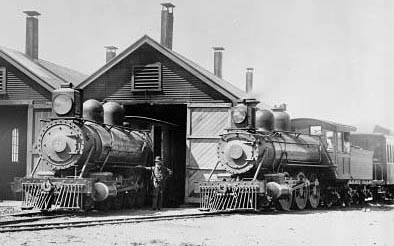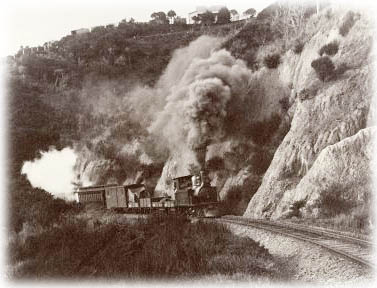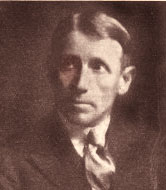The Big Bull Yank
From
WMRY.NetFirms

In 1891
the Wellington and Manawatu Railway Company ordered two Prairie type
(2-6-2) tender locomotives from the Baldwin locomotive works, Philadelphia,
U.S.A. to cope with increasing traffic on the Company's 84 mile line
between Wellington and Longburn.
The locomotives were intended to work the easily graded section of
line north of Paekakariki. Here the Baldwin 2-8-0s that brought the
trains through the hills from Wellington would hand their load to
the Prairie's for the fifty-seven mile run across the Manawatu plains
to Longburn. Both of them were in service before the end of the year,
being given road numbers 9 and 10.
The two engines soon proved to be favourites, not only were they more
powerful than their sisters, but they rode better and could run faster,
indeed it was their speed that ultimately made them legendary.
On the 20th July, 1892, No 10 headed out of Wellington with a special
speed trial train, consisting of the locomotive, a passenger car and
a van. After negotiating the hilly Wellington - Paekakariki section,
No 10 rapidly picked up the pace as she rolled onto the Manawatu Plains.
The loco ran freely at speeds of 50-55 m.p.h. and as she crossed the
Tokomaru swamp she ran fifteen miles in fifteen minutes, hitting a
top speed of 64.4 m.p.h. and thus setting the world speed record for
the 3ft 6in gauge.
The Wellington and Manawatu Railway Company
From
Wikipedia
The Wellington
and Manawatu Railway (WMR) was a railway between Thorndon in Wellington,
and Longburn, near Palmerston North
Unlike
many other early railways in New Zealand, it was privately owned.
At the time of the railway's founding, the government had already
constructed a railway linking Palmerston North and the sea-port at
Foxton, and was planning to extend its line to Wellington. However,
a group of Wellington businessmen grew impatient at the government's
delays, and chose to fund their own connection.
The WMR
was founded in 1881, and the laying of track was completed in 1886.
The WMR ran for about 134 kilometres. From central Wellington , the
line wound through the hills (1880s photo) to Johnsonville, then proceeded
to Tawa, Porirua, Paekakariki, Paraparaumu, Otaki, Shannon and Longburn.
The
decision to pass through Shannon meant that the line joined the
existing Palmerston-Foxton line in the middle, at Longburn, rather
than at Foxton. This route was chosen as being more direct.
A number of new towns were established along the railway's route,
notably Plimmerton, named after company director and 'Father of Wellington'
John Plimmer, and Levin, named after William Hort Levin, a director
of the company. The trains was advanced by standards of the time,
having comfortable carriages, electric lighting, and telephone communication
between stations.
The WMR was bought by the government in 1908, and integrated into
the New Zealand Railways Department.
Will Lawson
From
ADB.Online
 (1876-1957)
born at Gateshead, Durham, England When Will was 4 the Lawsons migrated
to New Zealand. His father joined the New Zealand Insurance Co.
and four years later was transferred to Brisbane. Here Will completed
his education at Brisbane Grammar School. After his family returned
to New Zealand in 1892, he worked as a clerk in the Wellington office
of the Australian Mutual Provident Society, where he remained for
the next eighteen years. (1876-1957)
born at Gateshead, Durham, England When Will was 4 the Lawsons migrated
to New Zealand. His father joined the New Zealand Insurance Co.
and four years later was transferred to Brisbane. Here Will completed
his education at Brisbane Grammar School. After his family returned
to New Zealand in 1892, he worked as a clerk in the Wellington office
of the Australian Mutual Provident Society, where he remained for
the next eighteen years.
Inspired by the poetry of Henry Lawson (no relation), Lawson began
to write ballads on sea and railway subjects. His first collection
of verse, The Red West Road, appeared in Wellington in 1903.
In
1912 Lawson moved to Sydney to work on the Evening News. He continued
to publish in the Bulletin and the Lone Hand, and met many of their
writers and artists. During World War I, medically unfit for active
service, he returned to New Zealand to write for various newspapers.
After the war he worked as a publicity officer and compiled tourist
guides. Over the following decade Lawson alternated between Sydney
and New Zealand, working as a journalist, publicist and travel agent.
|


 (1876-1957)
born at Gateshead, Durham, England When Will was 4 the Lawsons migrated
to New Zealand. His father joined the New Zealand Insurance Co.
and four years later was transferred to Brisbane. Here Will completed
his education at Brisbane Grammar School. After his family returned
to New Zealand in 1892, he worked as a clerk in the Wellington office
of the Australian Mutual Provident Society, where he remained for
the next eighteen years.
(1876-1957)
born at Gateshead, Durham, England When Will was 4 the Lawsons migrated
to New Zealand. His father joined the New Zealand Insurance Co.
and four years later was transferred to Brisbane. Here Will completed
his education at Brisbane Grammar School. After his family returned
to New Zealand in 1892, he worked as a clerk in the Wellington office
of the Australian Mutual Provident Society, where he remained for
the next eighteen years.